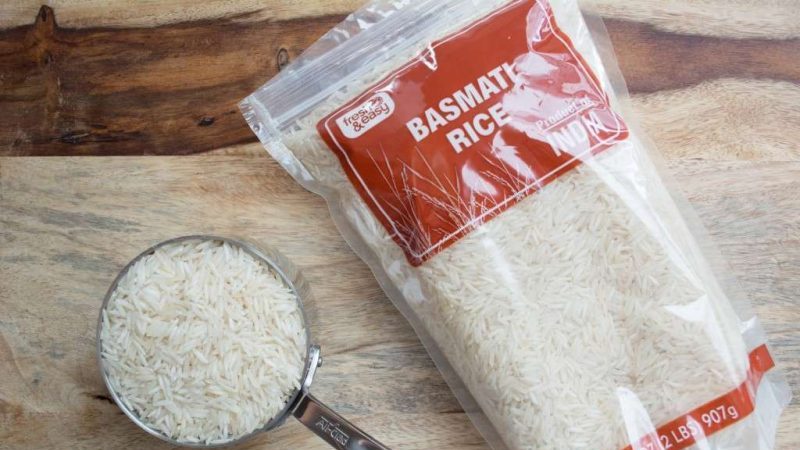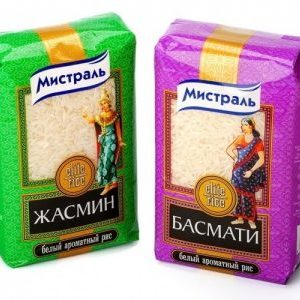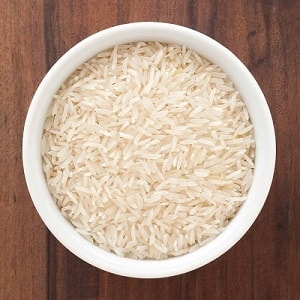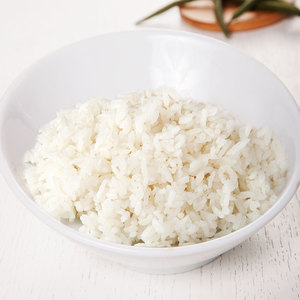What is the difference between jasmine rice and basmati rice: the difference in appearance, taste and application
Jasmine and Basmati are popular varieties of rice that you can easily find in large supermarkets. It is impossible to confuse them - the grains differ in shape and composition, but they also have similarities - a pronounced aroma. Their properties also vary, so they are suitable for preparing different dishes.
The content of the article
What is the difference between Jasmine and Basmati rice
First of all, they differ in the glycemic index. Have Jasmine its value is 109. Therefore, this variety is suitable for quick energy replenishment after exercise and for people with low blood glucose levels.
Rice Basmati has a glycemic index of 56 to 69, which makes it suitable for diabetics and adherents of a healthy diet.
Differences in appearance

Jasmine rice grains are white and slightly translucent. Risina has a narrow, oblong shape and a delicate milky aroma. During boiling in water, the grains stick together a little, but do not lose their shape. Rice is a fragrant variety because of its unusual floral scent.
Interesting. The cereal got its name due to the similarity with the white petals of jasmine. The most expensive varieties of this rice have a bright floral aroma.
Regular Basmati is more yellow in color. The grains are elongated. In its raw form, a nutty smell is also felt, even if the product is in an airtight package. When boiling, the grains are doubled.
The difference in the taste of Jasmine and Basmati rice
It is difficult to answer the question: which rice is tastier. Jasmine is ideal as a side dish for completely different dishes. It will complement the vibrant exotic cuisine, oriental products and the usual dinners and lunches for us.
 Jasmine rice retains its shape and dazzling white color even after boiling. From the very first minutes of cooking, a pleasant floral aroma will begin to spread through the kitchen. Also, the hostesses note the delicate taste. Moreover, it does not stick together and does not form lumps during cooking. Rice melts in your mouth.
Jasmine rice retains its shape and dazzling white color even after boiling. From the very first minutes of cooking, a pleasant floral aroma will begin to spread through the kitchen. Also, the hostesses note the delicate taste. Moreover, it does not stick together and does not form lumps during cooking. Rice melts in your mouth.
Basmati has a specific pleasant aroma and nutty flavor. This is due to the high content of the chemical compound 2-acetyl-1-pyrroline. The same compound is found in pandanus leaves - they are dried and used as a spice. A similar compound is found in cheese, fruits, and most cereals. For industrial purposes, Basmati is used to add aroma to baked goods.
Also, the cereal contains a minimum concentration of gluten (gluten), which is why it is easily washed and does not stick together.
Reference. Most housewives prefer Jasmine because of its delicate taste. It is even used for making desserts.
Application of jasmine rice
There are many recipes using Jasmine rice. The variety has gained popularity due to its versatility and versatility in cooking. It is used as a side dish in restaurants; it is also used to make rice porridge and pilaf. Jasmine does not absorb oil well, it remains on the surface of the grains.
Application of Basmati rice
Basmati is mainly used for cooking porridge, and various side dishes, spices and spices are often added to it, which complement the composition well. Basmati dishes are widespread in restaurants.
The product is suitable for all types of heat treatment, but steaming is the most successful for preserving taste and benefits. Rice, especially well boiled, absorbs oil well.
Important. Pilaf is not made from Basmati, as the grains will creep and turn into porridge.
How to cook both types of rice properly
Thoroughly rinse the Jasmine under cold water several times until the liquid becomes transparent... Pour about 400 ml of water into a container, add salt to taste. Place the grain in boiling water. Bring to a boil and reduce heat to low for 10-15 minutes. We remove from the stove and let it brew for about another 10 minutes.
We wash dry Basmati in water several times. Pour twice as much water into the pot as the grains. Pour rice into boiling water, cook for 5 minutes over high heat. When we see that the rice is ready, we leave it to infuse for 20 minutes. Add salt and spices as needed.
Council. Add rosemary, turmeric, black pepper, or white pepper for flavor. This will add a spice to the dish.
More about Jasmine Rice
Of the many varieties, Jasmine is considered the most delicious. The fragrant cereal is cultivated only in Thailand, but it is appreciated all over the world.
Jasmine (also called Fragrant Rice) was first grown in Thailand near Bangkok about 70 years ago. It is cultivated exclusively in the main season, from September, and the harvest is harvested in December, as the tropical rainy season adds amazing properties to this crop.

Jasmine rice contains complex carbohydrates and ensures long-term satiety. It does not create spikes in insulin in the blood, unlike fast carbohydrates (sugars), which are absorbed almost immediately. Jasmine rice is a hypoallergenic product that is free of gluten (gluten). Suitable for diets and proper nutrition.
Calorie content the product is 338 kcal per 100 g.
Composition:
- fats - 0.4 g;
- proteins - 7.2 g;
- carbohydrates - 79 g.
And:
- ash - 0.64 g;
- saturated fatty acids - 0.18 g;
- water - 11.62 g;
- monosaccharides and disaccharides - 0.12 g;
- fiber - 1.3 g
There are vitamins and useful elements in the cereal:
- vitamins B1, B2, B4 B6, B9;
- vitamin K;
- vitamin E;
- vitamin PP;
- iron;
- magnesium;
- sodium;
- calcium;
- iodine selenium;
- zinc;
- phosphorus;
- manganese.
Harm and benefit
Rice is rich in trace elements and vitamins that stimulate metabolism. If you are slimming, this product will definitely suit you.
Jasmine is included in the diet for:
- dietary food;
- diseases of the cardiovascular system;
- problems of the gastrointestinal tract;
- poisoning;
- endocrine system disease;
- oncological diseases.
The fiber in jasmine rice helps to remove toxins and toxins from the body.
Important. Jasmine is contraindicated in people with diabetes due to its high glycemic index. With a tendency to constipation, they should also not be abused.
More about Basmati rice
Basmati - variety long-grain aromatic rice, which has been cultivated since time immemorial in the foothills of the Himalayas. The traditional producers and suppliers of this cereal are India and the Pakistani province of Punjab.
Basmati means "fragrant" in Hindi. According to historical records, grow it began on the Indian subcontinent more than 3 thousand years ago. Initially, Basmati was used to refer to all varieties of aromatic rice, however, over time, the term was applied exclusively to products of special quality. Thanks to Indian merchants, the whole world learned about Basmati. Today, this rice has become an integral part of many Middle Eastern culinary traditions.
The energy value of rice per 100 g is 370 kcal. The ratio of proteins, fats and carbohydrates:
- Proteins - 7.94 g;

- Fat - 2.92 g;
- Carbohydrates - 77.24 g;
- dietary fiber - 3.5 g;
- water - 10.37 g.
Rice nutritional value - in milligrams per 100 g:
- thiamine (vitamin B1) - 0.401;
- riboflavin (vitamin B2) - 0.093;
- pantothenic acid (vitamin B5) - 1.493;
- pyridoxine (vitamin B6) - 0.509;
- folic acid (vitamin B9) - 0.02;
- tocopherol (vitamin E) - 1.2;
- phylloquinone (vitamin K) - 0.0019.
- calcium - 23;
- magnesium - 143;
- sodium - 7;
- potassium - 223;
- phosphorus - 333;
- iron - 1.47;
- zinc - 2.02;
- copper - 0.277;
- manganese - 3.743.
Harm and benefit
Basmati, or as it is often called "Indian", contains many vitamins and minerals. It is recommended in moderation during pregnancy. Folic acid contributes to the normal formation of the fetus, but overeating rice contributes to constipation.
A large amount of fiber has a beneficial effect on the digestive tract. The potassium in rice has a positive effect on the heart, thyroid and pancreas. The phosphorus in Basmati keeps bones strong. Due to the high content of amylase in the product, intestinal disruption may occur, and, as a result, colic may occur.
Caution! Don't overuse Basmati rice. People with individual intolerance and children under three years old should completely abandon this product.
Indian rice porridge is useful in case of heavy metal poisoning.
Rice harm
Despite all the benefits of rice, cereals can have a negative impact on human health. Nutritionists advise against excessive consumption of jasmine rice while losing weight due to its high calories... In addition, this product can cause constipation if consumed in large quantities.
Cereal dishes should be limited to people with diabetes. The product has a fairly high glycemic index, so exceeding the daily allowance leads to sharp jumps in blood glucose.
Scientists have already shown a link between excess rice consumption and the risk of diabetes. True, nutritionists cannot yet come to a consensus about the benefits and harms of the product. Some consider it safe, while others consider it a source of excess carbohydrates.
The risk of diabetes with the abuse of Jasmine rice increases by 1.5%, and this is already a tangible indicator. It is recommended to eat more brown rice, combining it with white and vegetables.
Conclusion
Jasmine rice is great for those who go in for sports, it has a high nutritional value and saturates the body for a long time. Basmati is suitable for diabetics, but athletes will also replenish their strength.
If Basmati cooks well into porridge and absorbs oil, then pilaf and restaurant side dishes are obtained from Jasmine. In moderate quantities, both varieties can be consumed by almost all people, including for diseases of the gastrointestinal tract, the main thing is to comply with the norm.